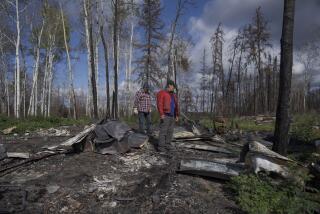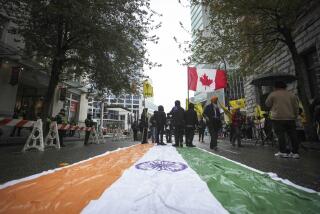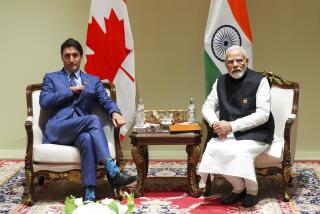Canada’s Mission in Gulf War Stirring Controversy at Home
TORONTO — Canada mounted its first official offensive missions of the Persian Gulf War on Sunday, intensifying controversy in Canada about this normally noninterventionist country’s role in the fighting.
It was the first time in 40 years--since the Korean War--that Canadian forces have been sent into battle, and the shift has been traumatic for many.
Canadian CF-18 warplanes took off from their wartime base in the Persian Gulf sheikdom of Qatar to join U.S. planes on “sweep and escort” missions over Iraq and Kuwait. Heavy clouds forced the first planes to turn back, but the Canadians are due to continue the missions when the weather clears.
In a sweep, the Canadian planes normally take off about 15 minutes ahead of their U.S. partner aircraft and fly over a target area to clear it of any hostile planes.
On escort missions, two Canadian planes fly off the wings of each U.S. bomber, trying to shoot down any Iraqi planes sent up to interfere with the air strikes.
Canadian military officials say the CF-18s are not presently set up to drop their own bombs, and they say it would take weeks for the Canadian pilots to be trained to mount their own air strikes.
But even the prospect of Canadian planes getting into dogfights, being shot down by Iraqi ground fire or helping America bomb Iraq has dismayed a people who have long taken pride in their country’s traditional peacekeeping role.
Canada “went to war confused, suspicious and resentful,” says Carol Goar, a political columnist for the Toronto Star. Recent polls have shown that about two-thirds of Canadians opposed sending Canadian forces into combat.
Until now, Canada has played mainly a symbolic and supportive role in the gulf, and Prime Minister Brian Mulroney, acutely aware of public misgivings, has maintained that Canada would stay far from the line of fire. When he initially dispatched the CF-18s to Qatar in September, he assured Canadians that they were going only to provide cover for the three aging warships that Canada also sent to the southern Persian Gulf.
But when the fighting began, the CF-18s began flying patrol missions over the gulf and Saudi Arabia--out of harm’s way, but closer to combat than the warships. In addition, modified Boeing 707s flown by Canadians have been helping the U.S. bombers refuel in midair.
The Canadian Parliament has seen stormy debate in recent days as Canada’s role has expanded. With demonstrators chanting outside, opposition legislators have argued that Mulroney should stop concentrating on war and instead pressure the U.S.-led alliance for an immediate cease-fire.
New Democratic Party leader Audrey McLaughlin argued that instead of sending the jets into combat, Canada should reassign the planes to protect field hospitals, food-supply lines and refugee caravans.
The New Democrats are Canada’s third-largest political party, and they have been doing well in the polls recently.
As the debate raged, however, Mulroney continued to deny that the Canadian planes really were on the offensive: They were merely “defending the basic integrity of the United Nations,” he said.
Meanwhile, the Canadian pilots who will actually be flying the newly authorized combat missions seemed pleased to be moving off the sidelines.
“I liked playing forward in hockey,” Capt. Christopher Sponder of the Canadian Air Task Group told a Qatar-based reporter for The Toronto Star.
More to Read
Sign up for Essential California
The most important California stories and recommendations in your inbox every morning.
You may occasionally receive promotional content from the Los Angeles Times.










